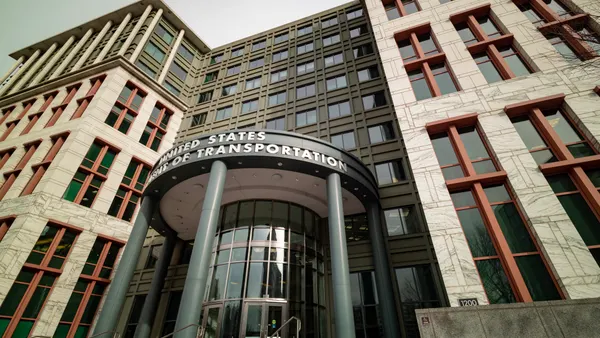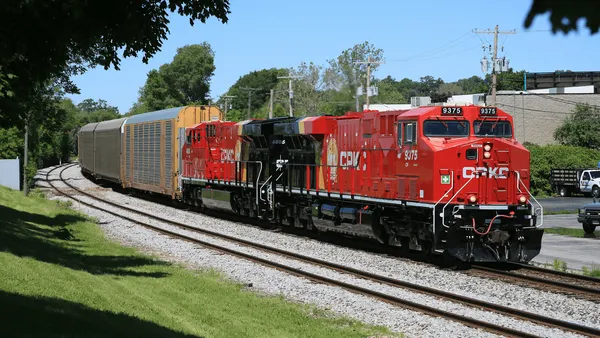UPDATE: May 27, 2020: The final HOS rule is set to publish in the Federal Register June 1 and will become effective Sept. 29, 120 days after publication.
Dive Brief:
- The FMCSA has finalized changes to HOS rules, the agency announced Thursday. The new rule addresses the sleeper-berth exception, the exception for adverse driving conditions, the short-haul exception and break periods.
- The agency said "modernizing" the HOS rules will save the U.S. economy and consumers nearly $274 million annually.
- The rule changes will become effective 120 days after they publish in the Federal Register.
Dive Insight:
Drivers have long asked for more flexibility in HOS rules. The original regulations gave truck drivers a 14-hour window in which they could drive up to 11 hours. That often created bottlenecks, if drivers were held up waiting for a container at a port or if they pulled off the road to avoid rush hour. The ELD mandate, effective starting December 2017, furthered that frustration.
"While our organization has been supportive of electronic logging devices, for many different reasons, we understand it created a capacity crunch in an industry that already has driver shortages in many sectors," Weston LaBar, CEO of the Harbor Trucking Association (HTA), told Transport Dive. "So, to create more flexibility ... that's a win for everybody. And that should benefit the shipping community and the consumers that buy the goods."
The FMCSA first alerted the public it would change HOS regulations in 2018. The agency then published a proposed rule in August 2019, more than two months behind the original schedule. After a comment period, it sent the proposed rule the Office of Management and Budget (OMB) for approval in March.
According to the FMCSA, the final rule institutes four changes:
- Requires a break after eight hours of consecutive driving and allows the break to be satisfied by a driver using on-duty, not driving status, rather than off-duty status.
- Modifies the sleeper-berth exception to allow drivers to split their required 10 hours off duty into two periods: an 8/2 split, or a 7/3 split — with neither period counting against the driver’s 14‑hour driving window.
- Modifies the adverse driving conditions exception by extending the maximum window during which driving is permitted by two hours.
- Extends the maximum duty period allowed under the short-haul exception from 12 hours and 100 air miles to now 14 hours and 150 air miles.
HTA members stand to benefit most from the on-duty, not-driving status modification to break times, LaBar said. Although drayage drivers don't typically max out their HOS, the original rules posed challenges during cargo surges creating port congestion.
In that situation, a truck at a marine terminal cannot not pull over, park and turn off the truck to take a break, like a highway driver could. Worst-case scenario, LaBar said, a driver would have to leave the terminal, pull off to the side of the road, take the mandatory break and hope to be let back into the terminal — something that typically does not happen.
Under the FMCSA's final rule, a driver at a terminal could count time spent waiting for a container as break time. "That flexibility I think really will help drivers in the drayage space," LaBar said.
He noted HTA members would have benefited from one HOS modification that was included in the FMCSA's proposal but did not make it into the final rule: a modification that would enable drivers to take one off-duty break of at least 30 minutes, but no longer than three hours, that would stop the clock on the 14-hour driving window.
To Oren Zaslansky, founder and CEO of Flock Freight, not having that as part of the final rule marks a missed opportunity. "I do think it's a loss. The ability to stop that clock is crucial," he told Transport Dive. Not having that ability is "a penalty to ultimately what is the speed of the supply chain."
How the supply chain adapts to the final HOS rule will depend on the company, Zaslansky said. Delivery speeds will likely accelerate, affecting the supplier, the consumer and everyone in between.
Advocates for Highway and Auto Safety, the Teamsters and other groups opposed to the HOS updates have voiced disappointment. Lamont Byrd, a director for the Teamsters, said the final short-haul rule "will result in an increase in occupation injuries and driver fatigue," according to a press release.
When asked if Advocates for Highway and Auto Safety considered challenging the final rule a spokesperson told Transport Dive via email, "We are are reviewing our options for recourse." A lawsuit in federal court could delay the rule's implementation.
This story has been updated with additional details.










